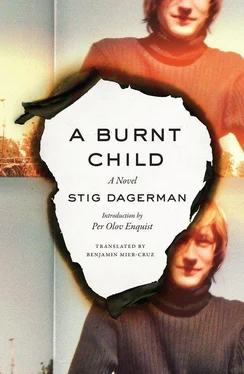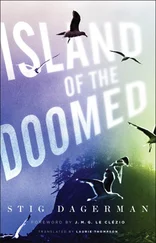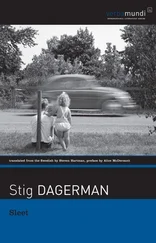In any event, this became A Burnt Child.
The following year he was sent to Australia by boat (there was always someone who sent him out, often a film company with a brilliant idea for the newly appointed genius) to write about the conditions of exile—a project he didn’t finish either. Then there was his final novel, Wedding Worries, a nosedive back into his childhood milieu, a story created nearly in panic as a burlesque and grotesque tragedy in a farming village. Then nothing for five years but new projects that always ended after three pages. Then a garage, closed doors, and a running car. There is perhaps no simple answer to the enigma of Dagerman’s career: why did it get so bright, and why did it end so soon?
One could say that his last two novels were about the internal disintegration of the family ( A Burnt Child ) and the village where he grew up ( Wedding Worries ): first he looked inward, then backward.
Then it was over.
A few days before taking his own life, he wrote in a letter to a worried female friend who had probably suspected something:
Somehow my life has come to a standstill, and I don’t know how I’ll be able to revive it. I can’t do anything anymore: can’t write; can’t laugh; can’t speak; can’t read. I feel like I’m outside the whole game. When I’m with people, I have to force myself to listen to what they are saying in order to smile at the right moments. And the last time I read Steppenwolf it hit me that I have a connection there, that is, not with the ones who take their own life out of necessity but the ones who always have death by their side as a matter of precaution, to speak with, to hope for. I don’t know why I’m still living. I see no end to the piling up of these senseless days.
I once read something by a Catholic about someone whom nobody could see because he concealed himself in light. If only we had some light to hide ourselves in. 5
Quoted in Erik Lindegren’s review of Island of the Doomed in Bonniers Litterära Magasin 9 (1946). Lindegren’s review is also reprinted in 40-talsförfattare: ett urval essäer om svenska författare ur 40-talsgenerationen, ed. Lars-Olof Franzén (Stockholm: Aldus/Bonnier, 1965).
back
Lasse Bergstöm’s foreword to Stig Dagerman’s Letters, in Stig Dager-man: Brev, ed. Hans Sandberg (Stockholm: Norstedts Förlag, 2002), 1o.
back
From Dagerman’s letter to Axel Liffner in 1946, in Stig Dagerman: Brev, 96.
back
From Dagerman’s letter to Ragnar Svanström in 1949, in Stig Dagerman: Brev, 214.
back
From Dagerman’s letter to Inga Landgré in 1954, in Stig Dagerman: Brev, 325-26.
back
It is not true that a burnt child dreads the fire. It is drawn to it like a moth to a flame. It knows that when it goes near it, it will burn itself again. Still, it gets too close.

A WIFE IS TO BE BURIED AT TWO O’CLOCK, and at eleven-thirty the husband is standing in the kitchen in front of the cracked mirror above the sink. He hasn’t cried much, but he has lain long awake and the whites of his eyes are red. His shirt is white and bright, and his freshly ironed pants are faintly steaming. As his youngest sister adjusts the stiff white collar behind his neck and draws the white bow across his throat so tenderly that it feels like a caress, the widower leans over the sink and peers searchingly into his eyes. Then he rubs them as if wiping away a tear, but the back of his hand is still dry. The youngest sister, who is the beautiful sister, holds her hand still at his throat. The bow tie gleams white as snow against his ruddy skin. He furtively strokes her hand. The beautiful sister is the sister he adores. For he adores anything beautiful. The wife was ugly and sick. Which is why he has not been crying.
The ugly sister is standing at the stove. The gas is hissing, and the lid of the shiny coffeepot is bobbing up and down. With red fingers, she fumbles after the valves to turn it off. She has lived in town for twelve years now, but she still hasn’t figured out the gas valves. She wears black-rimmed glasses, and whenever she wants to look someone in the eye, she leans in closely and stares awkwardly. Finally, she finds the right valve and turns it off.
Should it be a white tie for a funeral?
It is the beautiful sister who asks. The widower is fiddling with his cuff links. He has long black shoes, and they squeak when he abruptly stands on his toes. But the ugly sister spins around sharply as if someone had come at her.
White to a funeral! I should know after the consul’s!
Then she purses her lips. Her eyes blink behind her glasses as if they were afraid. They probably are. She knows all about funerals but almost nothing about weddings. The beautiful sister smiles and continues making adjustments and being caressed. The ugly sister moves a vase of white flowers from the table to the sink. The widower looks in the mirror again and suddenly finds himself smiling. He closes his eyes and breathes in the smell of the kitchen. For as long as he can remember, funerals have smelled like coffee and sweaty sisters.
But a mother will also be buried, and the son is twenty years old and nothing. He is standing by himself under the ceiling light in the room full of people. His eyes are a little swollen. He has flushed them with water after a night of crying and thinks no one will notice. But in reality everything is noticeable, so the funeral guests have left him alone. Not out of respect but out of fear, because the world is afraid of those who cry.
The father stands perfectly still for a while, not even playing with his cuff links or tugging at his mourning band. The golden pendulum clock, a fiftieth birthday present, strikes a thin, thin note. The guests are standing by the windows and murmuring. Their voices are veiled in mourning, but someone from the father’s side is tapping a march on the windowsill with his knuckles. The knuckles are hard and he wishes they would stop. But they don’t. Then someone who traveled all the way from the country turns on the radio, although it isn’t even noon yet. It hums and hums, but no one has the sense to turn it off.
Soundlessly, the January light falls into the room and gleams over all the shiny, squeaky shoes. At the center of the room there is a large and freshly vacant space under the ceiling light, where the son is standing by himself and watching and listening to everything. Although he is really somewhere else. Before his mother died and he ended up alone, there used to be a long oak table where he is standing, but now the table is by the window. A white tablecloth is spread over it and on top of the cloth are glasses, carafes with dark wine, fifteen fragile white cups, and a big brown cake that is sweet but will taste bitter. Today, the mother’s portrait is on this very window-table, behind the carafes in a heavy black frame. It is wreathed with greenery, January’s precious greenery. As the funeral coffee brews, and the pastor shaves at the parsonage, and the gas tanks of the funeral cars are filled in the garage, the eleven guests gather around the table and the photograph of the deceased. She is young in the photograph. Her hair is still thick and dark, and it drapes heavily over her smooth brow. Her teeth, which are scarcely visible between her round lips, are white and untarnished.
She was twenty-five then, one of them says.
Twenty-six, corrects another.
Читать дальше













